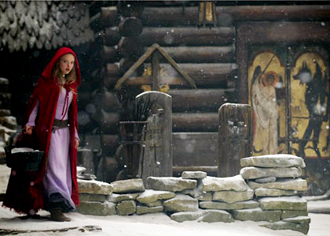"Little Red Riding Hood:" Still a Lively Tale
The elements are simple a girl, a wolf, an encounter in the woods. Originally a 17th-century fairy tale, “Little Red Riding Hood” has an innocent child at its heart, but the story and its characters have morphed into tantalizing and edgy portrayals in today's films, ads and literature, says Harvard University folklorist Maria Tatar.

Premiering next month, the new movie Red Riding Hood puts a Gothic twist on the fairy tale. The director is Catherine Hardwicke, known for her Twilight vampire series. (Images from Warner Brothers)
Still a favorite with children, “Red” can be much more than a tale about a little girl deceived by an evil, talking wolf on the way to her grandmother's house and, in some versions, rescued by a huntsman. The deeper meanings of the tale also resonate with adults, as Tatar illustrated with images during her lecture at Tulane on Thursday (Feb. 17).
“We think of the story as archaic and primitive, but it's alive in our culture,” said Tatar, who is the John L. Loeb Professor of Germanic Languages and Literatures.
Why does the story “stick” through time? Tatar says people are drawn to the tale because of its themes food, sex, death, survival and mortality. Like all fairy tales, it helps us make sense of our own world.
“The conflict between vulnerable innocence and brute force, it gives us an opportunity to talk about them and think them through,” she says. It engages primal fears and desires and in more recent times has turned “naughty, sultry” in such films as the twisted take on Red Riding Hood in the 1996 Freeway starring Reese Witherspoon.
With hundreds of articles and many books in academic literature inspired by the fable, “Red” is a thriving “growth industry,” she said. “The story will not go away.”
The Germanic and Slavic Studies Department and the German Club, along with numerous other Tulane groups, sponsored Tatar's lecture, entitled “From the Pagan to the Postmodern: Little Red Riding Hood Meets the Wolf.”
